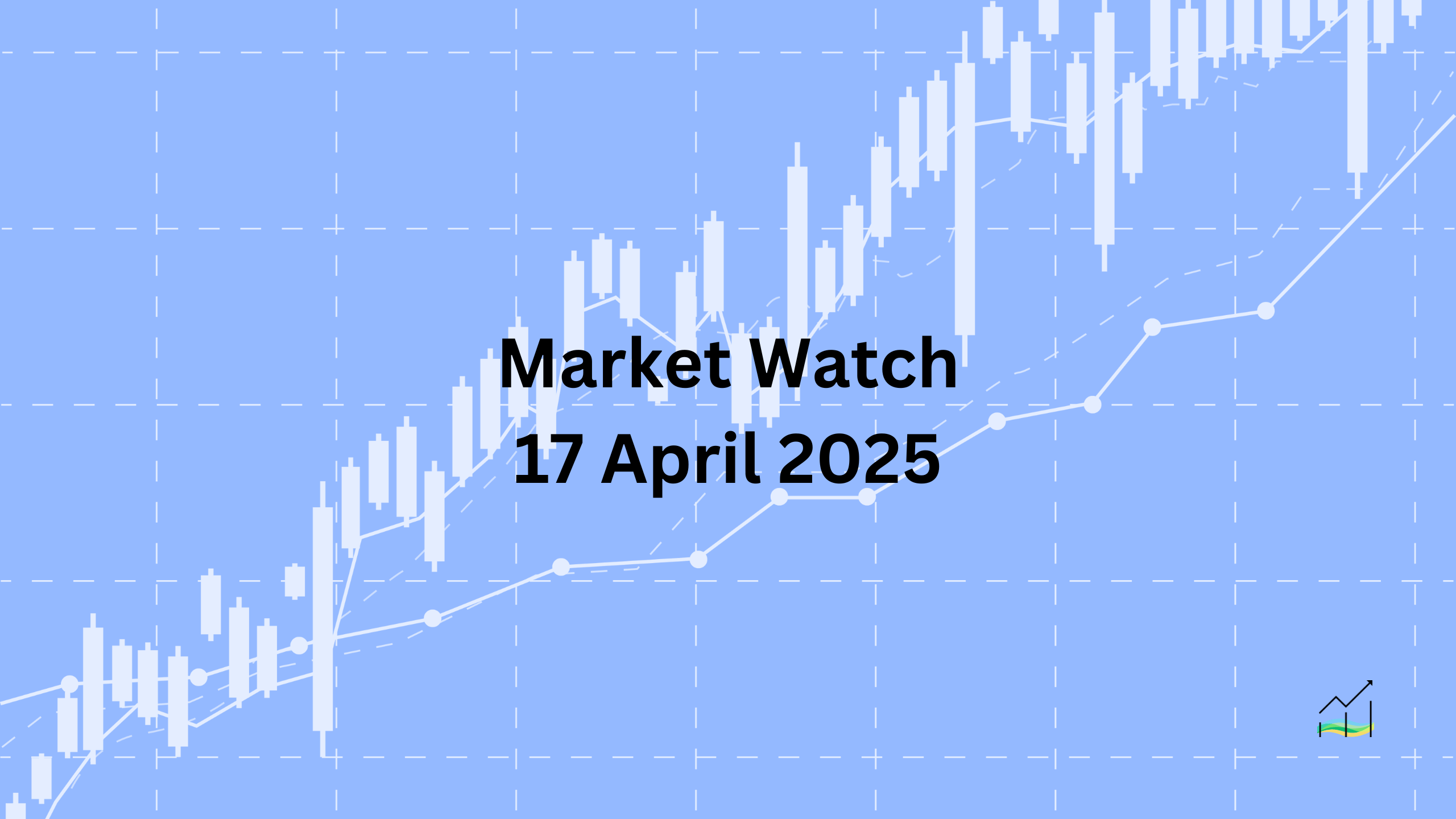17/04/2025 Market Watch

Dollar Steady Ahead of ECB Decision Amid Holiday-Thinned Trading
Key Takeaways:
- The dollar remains firm across G10 currencies, though trading is still within recent ranges.
- ECB is widely expected to cut rates, ahead of upcoming holidays across Europe and North America.
- Yen is the weakest performer after recent gains were reversed.
- US and European bond yields continue to rise.
- Gold hits a record high before pulling back; oil prices push toward April highs.
- Asian equities rise despite US market losses, but not all bourses participate.
The dollar holds steady against most of the major currencies, but remains within familiar ranges as traders prepare for a likely slowdown in liquidity. This comes ahead of a widely anticipated interest rate cut by the European Central Bank, which may be the last key event before markets quiet down for the long weekend. With public holidays across much of Europe and North America approaching, trading conditions are expected to thin out quickly.
The Japanese yen stands out as the weakest among the major currencies, reversing its recent gains after reaching a six-month high. The greenback is also firmer against most emerging market currencies, with a few exceptions like the yuan. The backdrop includes ongoing geopolitical noise, but no direct foreign exchange impact from recent trade-related remarks by President Trump.
Global equities present a mixed picture. While the Asia Pacific region rebounded from Wall Street's losses, China’s CSI 300 and Taiwan’s Taiex were notable laggards. European stocks are slipping again after a strong start to the week, while US futures are attempting to recover from the previous session’s sharp decline. Meanwhile, bond yields are trending higher across major economies, including the US, Japan, and parts of Europe, reflecting persistent inflation concerns and market repositioning.
In commodities, gold set a fresh record high above $3350 before facing a wave of profit-taking. Buyers stepped back in near $3313. Oil prices are also showing strength, with June WTI crude pushing toward $63, marking its best level since early April. This suggests a firming tone in broader risk sentiment despite lingering market uncertainties.
United States of America
Overview
The Dollar Index remains under pressure, trading near recent lows as market participants await clarity from global events and central bank decisions. Despite a lineup of economic data releases, they are not expected to significantly impact markets ahead of the long holiday weekend. Attention remains fixed on trade developments, where geopolitical uncertainty continues to shape sentiment.
Economic Drivers
- The dollar remains defensive, with technical vulnerability emerging around the 99.00 level.
- Ongoing trade tensions are contributing to market caution, with speculation that the US may seek quick results to support its stance.
- The US administration maintains confidence in its trade position, though others argue China has a stronger ability to adapt through domestic stimulus and alternative markets.
- The Fed remains in wait-and-see mode, with Chair Powell reiterating a patient approach supported by a steady labor market and manageable inflation.
- Real economic data continues to outperform sentiment-based indicators.
Data and Events
- 18 April 2025 – Housing Starts.
- 18 April 2025 – Weekly Jobless Claims.
- 18 April 2025 – Philadelphia Fed Manufacturing Survey.
Price Action
- The Dollar Index is hovering between 99.20 and 99.75 in quiet trade.
- A break below last Friday’s low near 99.00 could open downside targets between 97.50–97.80.
- Current consolidation reflects cautious sentiment ahead of ECB meeting and holiday-thinned trading.
Key Points:
- Dollar Index remains weak, with key support near 99.00.
- Market is largely ignoring today's data ahead of the weekend.
- Trade tensions and tariff uncertainty weigh on sentiment.
- Fed maintains neutral stance as real data hold firm.
- Potential for technical breakdown if support fails.
Australia
Overview
The Australian dollar is trading near its strongest levels in nearly two months, supported by a sharp rally and better-than-expected employment data. While it briefly challenged the $0.6400 mark, it has yet to achieve a firm close above that level. The labour market showed signs of resilience in March, reinforcing positive momentum in the currency despite a slight rise in the unemployment rate.
Economic Drivers
- Australia added 32,000 jobs in March, rebounding after a 57,500 job loss in February.
- The unemployment rate rose slightly to 4.1%, partly due to an increase in the participation rate.
- The economy gained 15,000 full-time jobs in March, reversing a three-month trend of losses totalling around 23,000.
- The data signals underlying strength in the labour market, which supports a constructive outlook on domestic demand.
Data and Events
- 18 April 2025 – Labour Force Report (Employment Change, Unemployment Rate).
Price Action
- The Australian dollar rallied nearly 8% over the past six sessions.
- It approached $0.6400, a key psychological level not closed above since December.
- Support is holding near the five-day moving average, around $0.6340.
- Momentum indicators remain bullish, suggesting potential for further gains toward $0.6440.
Key Points:
- AUD nears $0.6400 resistance, a level not closed above since December.
- Jobs data reinforces strength despite a minor uptick in unemployment.
- Momentum stays constructive with upside potential toward $0.6440.
- Full-time job recovery supports the broader economic outlook.
Canada
Overview
The Canadian dollar is holding firm as the US dollar continues to trade within a tight range against it, staying near the lower end of its recent band. The Bank of Canada kept interest rates unchanged, acknowledging the drag from US tariff uncertainty on sentiment. However, speculation is growing that political timing ahead of the national elections may also have influenced the decision to hold steady.
Economic Drivers
- The Bank of Canada held its policy rate at 2.75%, citing uncertainty from US trade policies as a key risk.
- Business and consumer confidence are being dampened by external trade threats.
- The decision to hold may also reflect caution ahead of upcoming national elections.
- Market expectations for a June rate cut are growing, with implied odds around 37%—though some believe the probability is higher.
Data and Events
- 17 April 2025 – Bank of Canada Policy Rate Decision.
- 04 June 2025 – Next Scheduled Bank of Canada Rate Decision.
Price Action
- USD/CAD continues to consolidate within last Friday’s range of ~1.3840–1.3990.
- The pair is currently trading below 1.3900, toward the lower end of this band.
- Short-term bias remains neutral with no clear breakout direction yet.
Key Points:
- Bank of Canada kept rates unchanged at 2.75%, citing trade-related uncertainty.
- Political considerations ahead of elections may have influenced the hold.
- Markets expect a potential rate cut in June, with growing anticipation.
- USD/CAD remains rangebound, with limited directional conviction.
China
Overview
Despite escalating US tariffs, there are no signs that Beijing is responding through currency devaluation. The offshore yuan posted a bearish outside down day against the dollar but has shown minimal follow-through, instead consolidating in its tightest range in weeks. The yuan remains flat against the dollar year-to-date, indirectly weakening against other major currencies.
Economic Drivers
- No indication that China is using currency depreciation to offset US tariffs.
- The yuan’s year-to-date stability against the dollar implies relative weakness versus other currencies.
- The PBOC has slightly increased flexibility in its daily dollar fix, with recent average moves larger than earlier this year.
Data and Events
No major economic releases scheduled.
Price Action
- USD/CNH posted a bearish outside down day but follow-through was limited, holding near 7.2950.
- Trading is now confined to the narrowest range in several weeks.
- Subtle shifts in PBOC fixings reflect quiet recalibration, not active intervention.
Key Points:
- China is not countering tariffs through currency moves.
- Offshore yuan consolidates after a bearish setup.
- PBOC daily fix is showing slightly more flexibility.
- No major scheduled data; market tone remains cautious.
Europe & Switzerland
Overview
The euro and Swiss franc led G10 currency gains against the US dollar, reflecting growing market expectations of monetary easing from both central banks. The euro extended its rally before encountering resistance near key levels, while the Swiss franc remained firm amid low inflation and a weakening economic outlook. Policy decisions are now front and center, as the ECB is expected to cut rates today, and speculation is building that the Swiss National Bank may move earlier than scheduled.
Economic Drivers
- The ECB is widely expected to lower its deposit rate to 2.25%, the upper bound of the eurozone’s estimated neutral range (1.75%–2.25%).
- Further easing is anticipated as policymakers aim to move rates below neutral in the current cycle.
- The euro’s recent strength and falling oil prices have contributed to increased pressure on the ECB to act.
- In Switzerland, persistent franc strength and low inflation have raised expectations for a rate cut before the SNB’s next scheduled meeting in two months.
- The swaps market is pricing in a move back into negative rate territory for Switzerland.
- The Swiss government warned that US tariffs will weigh on growth, lowering its forecast from 1.4% to 1.1%, with downside risks remaining.
Data and Events
- 18 April 2025 – European Central Bank policy rate decision.
- 18 April 2025 – Market speculation rises on potential unscheduled SNB rate cut.
Price Action
- EUR/USD rose above $1.1380, touching nearly $1.1415 before falling back to $1.1345 in Asia.
- Sellers emerged again near $1.1390 in early European trading, keeping the euro below weekly highs of $1.1425 and last Friday’s peak at $1.1475.
- The Swiss franc matched the euro in strength, maintaining pressure on USD/CHF.
- Intervention risk from the SNB exists, but is constrained by geopolitical sensitivities with the US administration.
Key Points:
- ECB is expected to cut rates to 2.25% amid currency strength and weak inflation.
- Further ECB easing is likely as rates move below neutral.
- Swiss franc strength and low inflation raise odds of a surprise SNB cut.
- Swiss growth outlook downgraded due to US tariffs.
- EUR/USD capped by resistance; CHF remains firm on policy and macro risks.
Japan
Overview
The yen weakened despite broad US dollar selling, as traders digested trade comments from President Trump and Japan’s mixed export data. While volatility and trade tensions have disrupted traditional correlations, political signals and intervention history continue to weigh heavily on sentiment. Japan’s trade balance showed a surplus in March, but declining exports to China and Europe reflect ongoing external demand challenges.
Economic Drivers
- The 30-day rolling correlation between USD/JPY and US 10-year yields has broken down, now near 0.25 — its lowest since late 2023.
- In contrast, correlation between the USD/JPY exchange rate and the Dollar Index has surged above 0.75, a five-month high, highlighting the strength of the overall dollar move.
- President Trump mentioned “big progress” in trade talks, temporarily weakening the yen.
- The US and Japan are expected to discuss foreign exchange directly during upcoming meetings.
- The yen remains politically sensitive after Japan spent ~$100 billion last year to support it.
Data and Events
- 18 April 2025 – Japan March trade balance reported at JPY544 billion surplus.
- 18 April 2025 – US-Japan trade talks continue, with FX discussions likely to follow.
Price Action
- USD/JPY fell below 142 for the first time this year.
- Key technical levels include last year’s low near 139.60 and 139.25, the 38.2% retracement of the post-Covid rally from ~102.60.
- Yen briefly weakened after Trump’s positive trade remarks and clarification that FX was not yet discussed.
- Selling pressure on the dollar continues, but yen reaction remains muted due to political risk.
Key Points:
- Traditional bond-yield correlation with yen has broken down due to volatility.
- USD/JPY now tracks more closely with Dollar Index strength.
- Japan’s March trade data showed solid headline surplus but weaker China/Europe exports.
- FX policy expected to be raised in upcoming US-Japan talks.
- Political pressure and past intervention keep yen direction cautious.
United Kingdom
Overview
Sterling’s recent surge against the US dollar has lost momentum after a strong seven-day rally — its longest winning streak since July 2020. The pair briefly approached $1.33 before reversing lower, with intraday volatility keeping it below key resistance. Despite this week’s employment and inflation data, expectations for a Bank of England rate cut next month remain unchanged.
Economic Drivers
- The market continues to price in a 25 bp rate cut at the Bank of England's next meeting.
- This week’s employment and inflation data had little effect on policy expectations.
- Rate expectations have remained stable since last Thursday, showing confidence in a forthcoming cut.
Data and Events
- 17–18 April 2025 – Labour market and inflation data released; no change to rate cut expectations.
Price Action
- GBP/USD extended its rally to just under $1.33 before reversing.
- It dropped to a session low near $1.3210, before recovering above $1.3250.
- The pair has struggled to break back above this level.
- The recent seven-day rally matched its longest stretch of gains since July 2020.
Key Points:
- Sterling rally stalls after a sharp multi-day climb.
- Resistance near $1.3280 is holding firm.
- BoE still expected to cut rates by 25 bp next month.
- UK data this week did not shift market expectations.
- GBP/USD volatility remains elevated near key levels.
© 2025 SKONE Enterprise (003319453-V). All rights reserved.
The content on this site is for informational purposes only and does not constitute financial advice.


